Most modern drivers, fairway woods and hybrid golf clubs feature a “bulge” designed into the face.

As illustrated below in red, bulge is a convex curvature spanning from the heel to the toe.
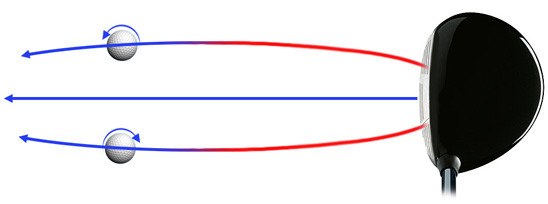
Clubs are built with bulge to induce “gear effect” on off-center contact. When the ball misses the club's center, the head rotates and imparts sidespin on the ball. For example, contact on the toe area causes hooking sidespin, sending the ball left of target. The face's bulge causes the ball to start to the right, compensating for the spin and delivering a straighter shot.
This effect is illustrated below, in red.
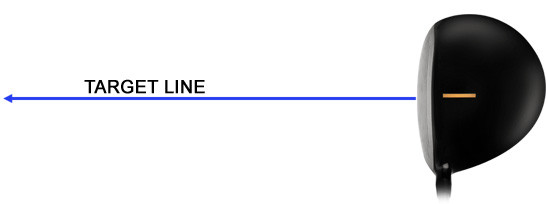
Bulge can help with shot correction, but there is also downside. For the golfer, looking at a curved face makes it much more difficult to accurately aim the golf club at the target. If you tend to focus on the heel area when setting up, the clubface will actually end up open. Similarly, if you tend to focus on the toe area, the face will be closed.
This problem can be solved by golf clubs with a clear and accurate shot aiming indicator designed into the top of the clubhead. (For example, the gold indicator shown in the picture above is positioned on a flattened crown to ensure it is straight and parallel to the ground.) Focusing on the alignment aid, instead of the clubface, prevents misalignment due to bulge.
All clubs made by Thomas Golf feature a patented, built-in alignment guide.
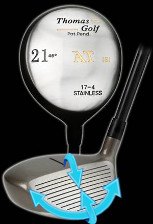
Bulge Roll Face Gear Effect – How It Helps Your Golf
On the surface, it seems to make sense that the faces of your golf clubs should be flat. After all, you are trying to hit the ball straight at a target, so wouldn't a flat face be the best option? When it comes to irons, the answer is yes. Most likely, the irons within your set of clubs will have flat faces, as that is standard practice in the world of golf. However, the story is a bit different when it comes to drivers, fairway woods, and hybrids. On these longer clubs, the face tends to have bulge and roll – meaning it is not actually flat. Why would that be? The answer comes down to something called the gear effect.
First, before getting into the details of this topic and what it means for your game, you need to be sure to understand exactly what kind of curve is on the face of your woods and hybrids. When you have a moment, take your driver from your golf bag and run a finger across the face from heel to toe – you should quickly notice that there is a noticeable bulge in the face of the club. Next, run your finger across the face from the bottom up to the top – again, you will notice that the face is curved, and this curve is known in golf as 'roll'. While the other woods and hybrids in your bag will likely not have as much bulge and roll as your driver, the idea is the same across the board.
So, now you have seen first hand just how much bulge and roll is present in the long clubs in your set. But what is the point of that specific piece of design? In this article, we are going to talk about the benefits of bulge and roll, and how you can use gear effect to your advantage to play better golf. This might seem like a subtle point and a minor topic in the overall scheme of the game, but it is important to understand nonetheless. Educating yourself on how your clubs work and how they relate to the swings you make is a valuable way to make yourself a better player.
While it is helpful to understand the idea behind gear effect, don't fall into the same trap as many other amateur golfers in thinking that your equipment can do the work of playing great golf for you. No matter how much money you spend on clubs and other equipment, and no matter how many nice golf shirts you buy, it will always be up to you to hit the shots in the end. Equipment has always been an important part of golf, and it continues to be important, but at the end of the day your success or failure will come down to your technique and your nerves. With well-rehearsed technique and a steady nerve, you can overcome just about anything on the course.
Any all of the content included below is based on a right handed golfer. If you happen to play left handed, please take a moment to reverse the directions as necessary.
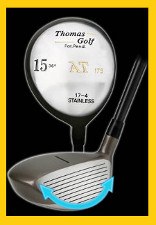
What is Gear Effect?
The idea of gear effect is at the heart of this topic, and it is the reason why club designers choose to use bulge and roll within the faces of their drivers, fairway woods, and hybrids. When gear effect is experienced on one of your golf shots, the ball is going to tend to curve back toward the original target after starting off-line. This tendency is due to the bulge across the face of your club. Since the bulge gradually moves out and back from head to toe, the ball will strike a slightly different curve depending on where you make contact on the face. To get a clearer picture in your mind of this effect, review the points below.
- First, you should understand that when you hit the ball directly on the sweet spot, there will be no gear effect to experience. The club face is flat in the middle, meaning you are going to find a flat surface for the back of the ball when you make solid contact on the sweet spot. Obviously, this is your goal for each swing, as the sweet spot is going to give you the greatest combination of accuracy and distance. When you feel like you have hit a shot just perfectly, there is a good chance that the ball left the sweet spot at impact. Of course, no golfer is able to hit the sweet spot all the time, which is why the concept of gear effect is so important to pros and amateurs alike.
- Moving away from the sweet spot, you can see the gear effect in action when you hit the ball out off the toe. As the point of contact moves away from the sweet spot and towards the toe of the club, the bulge of the club face will begin to arc away from you. If you were to hit the ball off of this portion of the club, the shot will naturally start to the right of your target because of the angle of the club face. While that might seem like a problem, there is good news – thanks to the gear effect, this kind of shot is also likely to have some draw spin, which will help the ball come back toward the target after starting to the right. When the ball comes together with the club face, and contact is made on the toe, the club face is going to open up due to the force of impact. As the face opens, the ball is going to spin from right to left as a result (much like two gears working together turning in opposite directions). In the end, the ball is going to leave to the right, spin back to the left, and hopefully it will wind up somewhere near the target when all is said and done.
- As you might expect, everything is going to work the same – only in reverse – when you hit the ball in off the heel. In this case, the ball is going to start to the left, but it should have fade spin when it leaves the club. After starting to the left, the ball will quickly start to cut back to the right, and the shot should be at least decent when it comes down. Shots hit off the heel usually feel a bit worse through your hands than shots off the toe, but gear effect can help you no matter which kind of mistake you happen to make.
So, to summarize – if you hit the ball off the toe, it should start to the right and curve back toward the target. Or, if you hit the ball off the toe, it is likely to start to the left and curve back to the right before it lands. Obviously, this is a helpful piece of club design that can make it easier for the average player to keep their ball in play all day long.

Focus on the Goal
It is great to have gear effect on your side when you take the club back to start any swing. When you look down from address to see that there is bulge and roll built in to the face of your driver, for example, you can draw some confidence in knowing that this design feature is working to help you. However, the ultimate goal is to not have to use that gear effect to keep your shots in play. Rather, you want to strike the ball perfectly on the sweet spot as often as possible to hit powerful and controlled shots. As mentioned earlier, no one is able to hit the sweet spot every time – but that shouldn't stop you from trying to find it as frequently as you can.
So what can you do to hit the sweet spot more frequently? Consider the tips listed below -
- Stay within yourself. One of the leading causes of poor contact is trying to swing harder than you are capable of doing in a controlled manner. While it is great to hit the ball hard, you don't want to swing so hard that you lose your balance at any point. You need to stay controlled and balanced if you are going to hit the sweet spot, so shorten up your backswing slightly and stay under control. You might be surprised to find that when you do swing under control, the ball will still travel good distances simply because you are hitting the sweet spot more frequently. This is a tip that certainly applies to your driver, but it is relevant to every club in your bag from top to bottom.
- See the ball. It is going to be hard to put the ball on the sweet spot of the club if you don't actually watch the ball while you hit it. As you make your swing back and through, be sure to focus your eyes directly on the back of the golf ball throughout the action. Most players do a good job of watching the ball during the backswing, but many lose focus as they start the downswing and want to look up to see where the shot is going to go. Don't fall for this temptation. Watch the ball all the way through impact and only look up when you are sure the ball is well on its way.
- Stay down. In addition to missing either out off the toe or in off the heel, you can also miss the sweet spot by hitting the ball either too high or too low on the face. To avoid dealing with this problem, work on keeping your feet flat on the ground through impact. Many golfers come up onto their toes as they swing down, but that small action is going to make it harder to strike the ball cleanly. To master this point, make your left heel a point of focus as the downswing begins. As long as you keep that heel locked to the turf as you swing through, it should be relatively easy to catch the ball cleanly at the bottom.
Gear effect is something that is great to have on your side – but you never really want to use it. Instead, you would always prefer to catch the ball perfectly on the sweet spot so you can get great distance from your shots while sending the ball right toward the target. You are inevitably going to have to rely on gear effect from time to time during the course of a round, but put the three tips above to use and the sweet spot on your clubs should get more and more use.
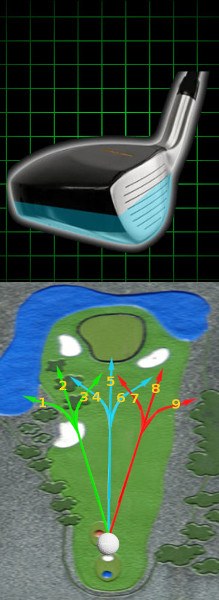
What to Expect on Toe and Heel Shots
When you do miss the sweet spot, it is helpful to know what you should expect out of your ball flight. We have already covered the fact that the ball is going to tend to return to the original target line thanks to draw or fade spin (depending on if you hit the toe or heel), but there are going to be other effects on your shots as well.
For one thing, you should always expect shots hit on the toe or heel to travel a shorter distance than similar shots struck on the sweet spot. Missing the sweet spot is going to cause the club head to twist at impact, and that twisting is going to equate to lost distance in the end. The amount of distance you lose depends on a number of factors, including the club you are using, your lie, your overall swing speed, and more. There is no way to accurately predict how much distance will be lost when you miss the sweet spot, but it can range anywhere from a few yards on a slight miss-hit to 15 – 20 yards, or more.
For example, imagine you are standing on the tee of a long, straight par four. Naturally, you take your driver from the bag, tee the ball up high, and make a big swing you hope will send the ball deep down the fairway. If you catch the sweet spot, you should get your wish, as the ball will have plenty of speed when it leaves the club face. Assuming you aimed properly and swung the club down the line with a square face, you will almost certainly be thrilled with the results of your drive.
Of course, there is a chance that you won't actually hit the ball on the sweet spot. If, instead, you hit the ball off the toe, your results may be slightly different. Instead of shooting directly down the fairway at high speed, the ball is going to start out to the right and gradually work back toward the fairway as it flies. There won't be as much speed on the ball, since you missed the sweet spot, so the shot is going to come up short of the one that you hit right in the middle of the face. In the end, each ball should be in the fairway, but the ball that came off the toe will be significantly short of the well-struck drive.
The other difference that you should expect to see with off-center hits is the fact that the ball will usually stay lower to the ground. There is likely to be less backspin on most of your off-center shots, and when you combine less spin with less overall speed, you get a shot that stays lower to the ground as it flies. This can be either a good or bad thing, depending on the situation. If you are playing on a firm golf course, a low shot might be a blessing in disguise, as you could get some extra roll to make up for the distance you lost in the air. On the other hand, playing a soft golf course will be trouble in this circumstance because the ball will land shot and probably not roll out much at all. Therefore, striking the ball cleanly when playing on soft conditions becomes even more important, as the turf isn't going to be able to help you recover some of your lost distance.
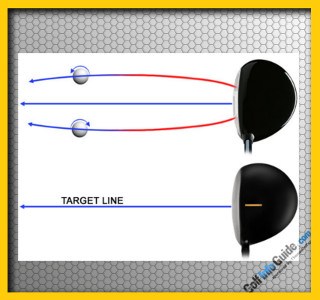
Playing for Gear Effect
Earlier, we stated that you don't really want to use gear effect – it is only there to help you live with your mistakes. However, that might not always be true. In some cases, it is possible to intentionally use gear effect to your advantage as you try to move your ball around the golf course. While you aren't going to do so often, hitting the ball intentionally off the toe or heel of the club to generate a desired ball flight is a technique you can turn to when absolutely necessary.
So when would you try this kind of extreme strategy? Most likely, the only time you are going to want to play the ball intentionally away from the sweet spot is when you absolutely have to turn the ball in a given direction. Let's say, for example, that you find yourself on the left side of the fairway, and there are trees between your ball and the green. To actually reach the green, you have to turn the ball from right to left around the trees. Unfortunately, there is a water hazard to the right of the green, so any shot that does not actually draw will wind up in the water.
What do you do? Of course, you could always just lay up and keep your ball safe. However, if you are wanting to go for the green, you will need to produce a swing which is going to cause the ball to curve significantly from right to left. If anything, you want the ball to curve too much, as it would be better to miss left in the rough than right in the water. If you try to draw the ball while hitting it on the sweet spot, you may or may not get the turn that you need in the air – after all, a ball hit perfectly on the sweet spot usually wants to fly relatively straight. So, you could set up with the ball aligned toward the toe, causing yourself to intentionally use the gear effect. This kind of shot may not come out beautifully, and it won't have full power, but it will almost certainly turn over and keep you away from the water.
This is a plan that can work in the other direction as well, when you need a fade rather than a draw. It should be noted, however, that the ball isn't going to fade as quickly or dramatically as it will draw when using the gear effect, so you shouldn't expect dramatic results. As with any shot that you are going to try on the golf course, always be sure to practice this technique before you put it into action during a round. It takes a reasonable level of skill to pull off this kind of shot, and you will get better and better at it with a little bit of time spent on the range.
Gear effect is an interesting topic within the category of golf equipment, and it is something that can have a real effect on the way you play the game. Most of the time, gear effect takes place in the background, helping to rescue your poor shots without you even thinking about it. However, as highlighted in the section above, you can intentionally use gear effect from time to time when you have a specific type of shot in mind. Before you purchase your next driver, fairway wood, or hybrid club, check out its bulge and roll characteristics to make sure it is going to offer you the gear effect advantages that you deserve on the course.






